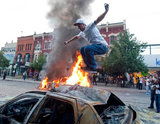
2010-07-15
Lesley Ciarula Taylor
The facial-recognition software Toronto police will use to track down suspects in its G20 summit investigation is an off-the-shelf tool that can sort through multiple databases very quickly.
The Canadian Bankers Association bought and installed the software because “the banks and the CBA have investigative functions, too. We investigate crimes against banks,” spokeswoman Maura Drew-Lytle said Thursday.
Their source is mostly “photos from security cameras” in banks, she said. Once the banks compile their information, “we turn it over to the police.”
In the G20 investigation, the CBA and its technicians trained in using facial-recognition software will help police try to match the pictures they have from images on many different databases, including those from Canada Border Services Agency.
Toronto police on Wednesday released photographs of 10 suspects and asked the public’s help in identifying them.
The cooperation between police and the CBA evolved after months of pre-summit meetings with banks, downtown merchants and police.
“It was all part of our planning to deal with security issues,” said Drew-Lytle. “We let the police know we had it. We have the licence and training. They said they would like our help.”

Bank security cameras, or any CCTV monitors, have a “large capacity to store information and retrieve it quickly,” a biometrics expert not involved with the CBA explained.
But to use it to match “a face in a crowd” to a database “is not a realistic application in the world today,” he contended.
The CBA software is bought from one of several companies that produce a variety of high-tech security systems. Drew-Lytle declined to say which one.
Once such company, L-1 Identity Solutions, produces the widely used FaceIt Argus facial-screening software, which markets itself to governments, high-security buildings and commercial operations such as banks to verify identities.
L-1 is not the CBA software provider, but it can explain in general how the technology works.
FaceIt software can scan multiple databases and produce results “in real-time” that distinguish between twins, the company says.
The Bay department store uses FaceIt to deter shoplifting. The software is configured to generate alerts when “known offenders” walk into one of its 600 stores. So far, the Bay’s Don Jobe said, the system has set off 22 alerts that have led to six arrests.
FaceIt captures its 3-D images through a live video stream using high-resolution cameras, the company said.